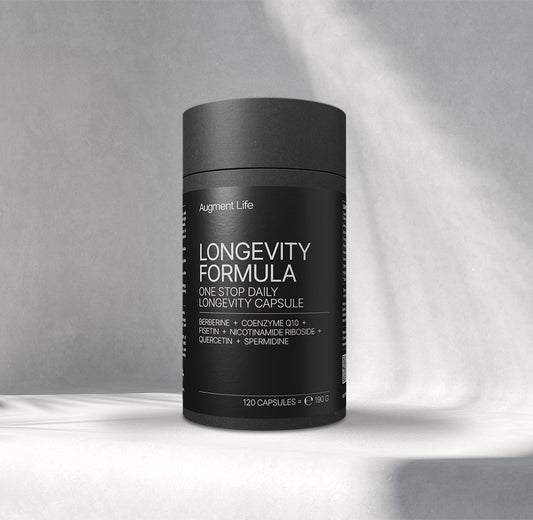I prodotti finali della glicazione avanzata o AGE sono proteine e lipidi con residui di zucchero attaccati. Si formano quando cuciniamo il cibo a temperature molto elevate, specialmente quando lo friggiamo o lo arrostiamo.
Sfortunatamente, possono essere pericolosi e causare molti danni ai nostri tessuti, organi e alla salute generale. Gli AGE sono persino implicati nello sviluppo di diverse malattie, come il diabete di tipo II, le malattie cardiovascolari, l'Alzheimer e l'ictus. Nel complesso, gli AGE causano danni a ogni cellula e sistema cellulare nel nostro corpo e sono una delle principali cause dell'invecchiamento, accanto allo stress ossidativo.
Gran parte della ricerca scientifica odierna è rivolta a scoprire come rimuovere gli AGE o impedire che causino danni. Molte molecole mostrano potenziale nell'inibire gli AGE, come metformina, resveratrolo e curcumina.
Come si formano i prodotti finali della glicazione avanzata?
I prodotti finali della glicazione avanzata (AGE) possono essere prodotti dal nostro corpo o trovati in alcuni gruppi alimentari in quantità molto piccole. Tuttavia, la maggior parte degli AGE con cui entriamo in contatto oggi deriva dalla preparazione del cibo tramite frittura, arrostimento o cottura ad alte temperature.
Ciò che accade è una forma di caramellizzazione chiamata reazione di Maillard. Le proteine e i grassi (lipidi) reagiscono con le molecole di zucchero del cibo e creano composti di proteine-zuccheri e lipidi-zuccheri. Poiché ci sono vari tipi di zuccheri, proteine e lipidi, ci sono molti tipi di AGE che possono essere formati. Gli alimenti ricchi di grassi e proteine, come la carne animale e i latticini, sono particolarmente inclini alla formazione di AGE (1).
Solo gli AGE più piccoli vengono consumati attraverso il cibo, mentre quelli più grandi possono essere creati nel nostro corpo. Attualmente non è chiaro quali di questi AGE siano più pericolosi.
Prodotti finali della glicazione avanzata - esempi
Alcuni degli AGE più famosi che si formano tramite cottura sono:
- NNϵ-carbossimetil-lisina (CML),
- Nϵ-carbossietil-lisina (CEL),
- pirralina,
- crossline,
- pentosidina,
- iimidazolio cross-link derivato da gliossale e lisina-lisina (GOLD),
- imidazolio cross-link derivato da metilgliossale e lisina-lisina (MOLD).
Queste molecole conferiscono anche al cibo colori, sapori e aromi specifici (2). Un famoso AGE prodotto naturalmente è chiamato metilgliossale (3).
L'assunzione di AGE sarà maggiore se mangi sempre molto:
- carne fritta/grigliata/arrostita, o cibo fritto in generale,
- burro e strutto,
- latticini interi,
- cibi processati.
Prendi in considerazione di mangiare più cibi freschi, crudi o a bassa temperatura, come insalate, verdure, cereali integrali, zuppe e stufati. Ad esempio, 1 uovo fritto ha 1240 kilounità di AGE, mentre 1 uovo strapazzato ha solo 75 kilounità di AGE (4). Puoi trovare l'elenco completo di cibi e linee guida su come avere una dieta a basso contenuto di AGE qui.
Prodotti finali della glicazione avanzata - sintomi
Avere alti livelli di AGE nel nostro sistema può causare:
- invecchiamento avanzato della pelle (rughe, perdita di elasticità, opacità),
- livelli aumentati di marcatori di infiammazione,
- danni al sistema vascolare,
- rigidità delle arterie,
- pressione alta,
- glicemia alta,
- resistenza all'insulina.
Un'assunzione elevata e prolungata di AGE attraverso il cibo può causare gravi danni ai reni, al cuore e al sistema vascolare.
I prodotti finali della glicazione avanzata possono essere rimossi?
Gli AGE vengono metabolizzati dal nostro corpo ed escreti nelle urine. Gli AGE devono prima essere scomposti in peptidi e amminoacidi liberi e alcuni AGE più grandi sono più difficili da scomporre. Tuttavia, i prodotti AGE degradati sono solitamente più dannosi degli AGE stessi e possono essere particolarmente dannosi per i reni dei pazienti diabetici.
Gli AGE sono un argomento di ricerca popolare e molti gruppi scientifici stanno cercando di determinare come impedire la formazione di AGE o come rimuoverli dal nostro sistema. Sfortunatamente, non ci sono ancora molte ricerche su soggetti umani, ma ci sono diversi studi condotti su modelli animali e cellulari, come ratti e topi.
Questi studi hanno scoperto che sostanze come metformina, resveratrolo e curcumina inibiscono o prevengono gli effetti negativi degli AGE. Ad esempio, la metformina impedisce la formazione di AGE (3) e la curcumina si lega ai recettori AGE nelle cellule e inibisce la secrezione di leptina (4). Il resveratrolo potrebbe avere un effetto simile sul muscolo cardiaco, dove previene i danni ai tessuti (5). Questi composti hanno un grande potenziale e rappresentano un nuovo entusiasmante approccio nella lotta contro gli AGE.
Fonti Letterarie:
- Poulsen MW, Hedegaard RV, Andersen JM, de Courten B, Bügel S, Nielsen J, Skibsted LH, Dragsted LO. Advanced glycation endproducts in food and their effects on health. Food Chem Toxicol. 2013 Oct;60:10-37. doi: 10.1016/j.fct.2013.06.052.
- Chuyen NV. Toxicity of the AGEs generated from the Maillard reaction: on the relationship of food-AGEs and biological-AGEs. Mol Nutr Food Res. 2006 Dec;50(12):1140-9. doi: 10.1002/mnfr.200600144.
- Kalapos MP. Methylglyoxal in living organisms: chemistry, biochemistry, toxicology and biological implications. Toxicol Lett. 1999 Nov 22;110(3):145-75. doi: 10.1016/s0378-4274(99)00160-5.
- Uribarri J, Woodruff S, Goodman S, Cai W, Chen X, Pyzik R, Yong A, Striker GE, Vlassara H. Advanced glycation end products in foods and a practical guide to their reduction in the diet. J Am Diet Assoc. 2010 Jun;110(6):911-16.e12. doi: 10.1016/j.jada.2010.03.018.
- Dutta S, Shah RB, Singhal S, Dutta SB, Bansal S, Sinha S, Haque M. Metformin: A Review of Potential Mechanism and Therapeutic Utility Beyond Diabetes. Drug Des Devel Ther. 2023 Jun 26;17:1907-1932. doi: 10.2147/DDDT.S409373.
- Tang Y, Chen A. Curcumin eliminates the effect of advanced glycation end-products (AGEs) on the divergent regulation of gene expression of receptors of AGEs by interrupting leptin signaling. Lab Invest. 2014 May;94(5):503-16. doi: 10.1038/labinvest.2014.42.
- Mizutani K, Ikeda K, Yamori Y. Resveratrol inhibits AGEs-induced proliferation and collagen synthesis activity in vascular smooth muscle cells from stroke-prone spontaneously hypertensive rats. Biochem Biophys Res Commun. 2000 Jul 21;274(1):61-7. doi: 10.1006/bbrc.2000.3097.











